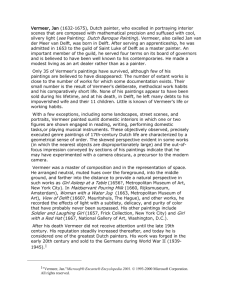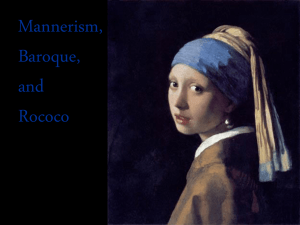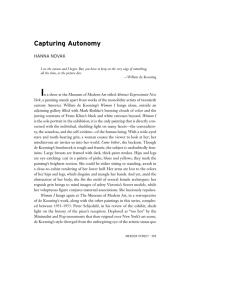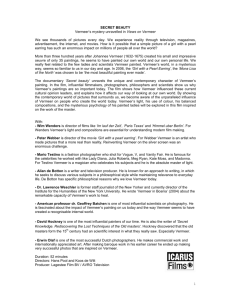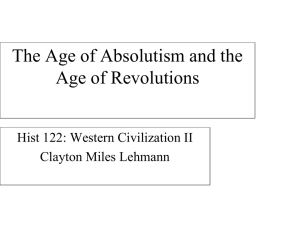Some Stories Behind the Paintings of Jan Vermeer
advertisement
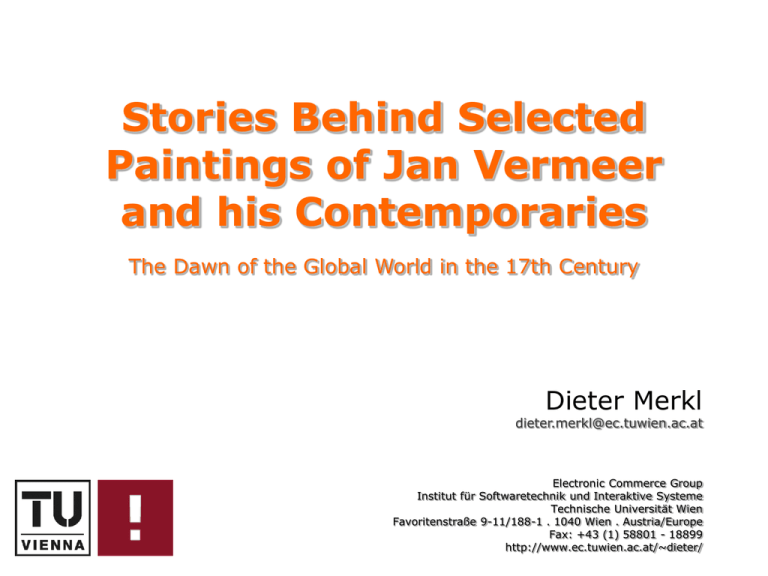
Stories Behind Selected Paintings of Jan Vermeer and his Contemporaries The Dawn of the Global World in the 17th Century Dieter Merkl dieter.merkl@ec.tuwien.ac.at Electronic Commerce Group Institut für Softwaretechnik und Interaktive Systeme Technische Universität Wien Favoritenstraße 9-11/188-1 . 1040 Wien . Austria/Europe Fax: +43 (1) 58801 - 18899 http://www.ec.tuwien.ac.at/~dieter/ View on Delft • • • • Jan Vermeer ~ 1660 96.5 × 117.5 cm, Oil on canvas Royal Picture Gallery Mauritshuis, The Hague, NL http://www.mauritshuis.nl/ Notes • tombstone in the Old Church of Delft • “View on Delft” was painted from the south, Vermeer must have had access to a somewhat elevated position • the tower of the New Church is shining in the sun • following to the left we see the tower of the Old Church Notes (2) • in the left foreground we see a passenger ship with some people waiting to get on board • two ships tied together on the right side of the picture are used for catching herrings • herrings have moved southwards into the North Sea because of a period of global cooling in the 17th century • the cooling was also responsible for the plague epidemics in that time Officer and a Laughing Girl • • • • Jan Vermeer ~ 1657 50.5 × 46 cm, Oil on canvas Frick Collection, New York, USA http://www.frick.org/ Notes • in the picture we see a soldier talking to a girl alone in a room • on the wall we see a map of the Netherlands • the map is oriented towards the west with land colored blue and water colored brown • for comparison see a map of the Netherlands from 1658 Notes (2) • the soldier is wearing an impressive hat made from beaver felt • the fur of beaver was treasured for making stable and water resistant hats • beaver population, however, was reduced due to hunting • so, alternatively, hats were made from felted sheep wool, not as stable as beaver though Notes (3) • beaver fur came to Europe from North America (Canada) - in exchange for knives • contact with native American population because of the search for a land passage to China through America Girl Reading a Letter by an Open Window • • • • Jan Vermeer ~ 1657 83 × 64.5 cm, Oil on canvas Gemäldegalerie Alte Meister, Dresden, Germany http://www.skddresden.de/en/museen/alte_meister.html A Maid Asleep • • • • Jan Vermeer ~ 1657 87.6 x 76.5 cm, Oil on canvas Metropolitan Museum of Art, New York, USA http://www.metmuseum.org/ Girl Interrupted in Her Music • • • • Jan Vermeer ~ 1658 78 x 67 cm, Oil on canvas Herzog Anton-Ulrich Museum, Braunschweig, Germany http://www.museum-braunschweig.de/ Woman With a Pearl Necklace • • • • Jan Vermeer ~ 1662 55 x 45 cm, Oil on canvas Staatliche Museen zu Berlin, Berlin, Germany http://www.smb.museum/ Reading Woman • • • • Pieter Janssens Elinga (1623 - ~1682) ? 75.5 x 63.5 cm, Oil on canvas Alte Pinakothek, München, Germany http://www.pinakothek.de/altepinakothek/ The Lute Player • • • • Hans Hendrick Maertensz (~1610 - 1670) 1661 52 x 39 cm, Oil on panel Rijksmuseum, Amsterdam, The Netherlands http://www.rijksmuseum.nl/ Notes • we see a woman reading a letter by an open window • it is a love letter, x-ray showed that Vermeer originally had a Cupid on the wall, which he omitted in the final painting • it is the same room as in “Officer and a Laughing Girl” and the woman is wearing the same dress • note the mirroring effect of the window Notes (2) • in the foreground we see a table • a Turkish carpet is moved aside, the carpet was too precious to cover the floor • on the table we see a bowl with fruit • the bowl is porcelain made in China • porcelain appears also in other paintings of Vermeer and his time • contemporary “Girl Reading …” made with Lego pieces Notes (3) • porcelain from China was valued in Europe • much finer than European tableware made of clay • Chinese salesmen sold pieces that did not meet the Chinese standard of beauty • some pieces were even built for the European market, e.g. bowls for soup the were considerably larger than the ones for the Chinese market The Geographer • • • • Jan Vermeer 1668 53 x 46.6 cm, Oil on canvas Städelsches Kunstinstitut, Frankfurt am Main, Germany http://www.staedelmuseum.de/ The Astronomer • • • • Jan Vermeer 1668 50 x 45 cm, Oil on canvas Musée du Louvre, Paris, France http://www.louvre.fr/ The Astronomer • • • • Gerrit Dou (1613 - 1675) 1650 27 x 29 cm, Oil on panel Stedelijk Museum De Lakenhal, Leiden, The Netherlands http://www.lakenhal.nl/ Notes • we see a person that is completely absorbed by his work • on the table we see a map • the geographer is holding a divider • he looks up in a moment of reflection • other maps are on the left in front of the windows and on the floor • on a cupboard we see a globe, made by Hendrik Hondius Notes (2) • the person possibly is Antony van Leeuwenhoek, a draper, surveyor and scholar on Delft • he appears also in “The Astronomer” by Vermeer • Antony van Leeuwenhoek acted as executor when Vermeer’s widow Catharina announces insolvency Notes (3) • the knowledge of the world was constantly increasing during the 17th century • geographers were integrating the observations of sailors to produce ever more exact maps • many ships wrecked because of incomplete knowledge of the world • the latitude was quite easy to determine for the navigator, the longitude was not until the 18th century • as an example a page of the Hondius-Atlas Woman Holding a Balance • • • • Jan Vermeer 1665 42.5 x 38 cm, Oil on canvas National Gallery of Art, Washington D.C., USA http://www.nga.gov/ Woman Weighing Coins • • • • Pieter de Hooch (~1629 - 1684) 1664 61 x 53 cm, Oil on canvas Gemäldegalerie, Berlin, Germany http://www.gemaeldegalerie-berlin.de/ A Man Weighing Gold • • • • Cornelis de Man (1621 - 1706) 1670 82 x 68 cm, Oil on canvas Private collection The Moneylender • • • • Gerrit Dou (1613 - 1675) 1664 29 x 23 cm, Oil on wood Musée du Louvre, Paris, France http://www.louvre.fr/ Notes • we see a woman holding a balance • the woman is possibly Vermeer’s wife Catharina • the painting was also known as “Woman weighing pearls” • there are, however, no pearls to be weighted on the table • there are, however, coins • weighing coins was a popular sujet in that time Notes (2) • maybe Vermeer was inspired by “Woman weighing coins” by de Hooch • weighing of coins was a common routine in the 17th century • because of usage the soft coins lost weight • essential for economic transactions was the price of the metal and not the face value printed on the coins • silver was the currency in the 17th century Notes (3) • silver came from Japan and South America • the Netherlands were exporting most of Japan’s silver, Spain and Portugal that of South America • the purchasing power of silver was higher in Asia than in Europe • so, most of the silver finally ended in China The End • Vermeer and his family were never particularly wealthy, they made their living through selling his paintings and his art trade • when France came to the Netherlands in the war of 1672, the art market came to a standstill with catastrophic consequences for artists like Vermeer • after he died on 15 December 1675 he was buried in the Old Church • his widow Catharina had to announce insolvency a little later Source • The idea for this presentation is based on the book Timothy Brook, Vermeer’s Hat: The Seventeenth Century and the Dawn of the Global World, Profile Books, London, 2008. Deutsche Übersetzung Timothy Brook, Vermeers Hut: Das 17. Jahrhundert und der Beginn der globalen Welt, Verlag Klaus Bittermann, Berlin, 2009. • The images were taken from Web Gallery of Art: www.wga.hu Wikipedia: de.wikipedia.org/wiki/Jan_Vermeer Essential Vermeer: www.essentialvermeer.com Flickr: www.flickr.com Mapsorama: www.mapsorama.com

